Two documents are essential if you want a seamless bidding process. Your Request for Proposal (RFP) and your bid leveling template.
The RFP serves as a guide for subcontractors when creating and submitting their bids while the bid leveling template helps you get the best value bid by performing an in-depth, line-by-line comparison of the received bids. The lowest-priced bidder is not always the best-value bidder.
While both documents require time and effort to get right, creating a bid leveling template is particularly intricate due to its reliance on multiple formulas, functions, and inter-tab linking.
Errors, whether in formulas, miscalculated costs, or even typos, can have significant consequences on the project.
The good news is you don’t have to create your template from scratch. We are giving you a free bid leveling template that you can customize based on your project to save time and reduce the margin for error.
Key Takeaways
- Bid leveling templates compare subcontractor proposals line-by-line to find best-value bidders.
- Template includes tabs for divisions, trade requirements, crane costs, subsistence expenses.
- Benefits: saves time, standardizes evaluation, minimizes errors with pre-built formulas.
- Best practices: create detailed RFPs, enable team collaboration through shared platforms.
- Downtobid automates with AI plan analysis, updated databases, integrated takeoff tools.
Download our free construction bid leveling template.
Note: If you need help dissecting construction plans and sending bid invites to relevant contractors, try Downtobid. Our AI tool automates bid invitation creation by pinpointing bid packages from construction drawings and quickly generating tailored subcontractor invite lists, speeding up the bid invitation and management process. Click here to try our software at no cost today.
Benefits Of Using A Bid Leveling Template
- Save Time: By eliminating the need to create a bid leveling sheet from scratch, you have more time to invest in other aspects of the bidding process.
- Bid leveling standardization: A bid template helps establish a standard operating procedure for leveling bids at your company. Having a documented way of evaluating construction bids means you never have to worry about missing crucial details in a bid, and it becomes extremely easy to onboard new employees into the process.
- Minimizes margin for error: When you use a bid leveling template, the foundation (formulas, function, and layout) has already been laid for you. You just need to build on it by filling out the appropriate sections.
An Overview Of Our Free Bid Leveling Template
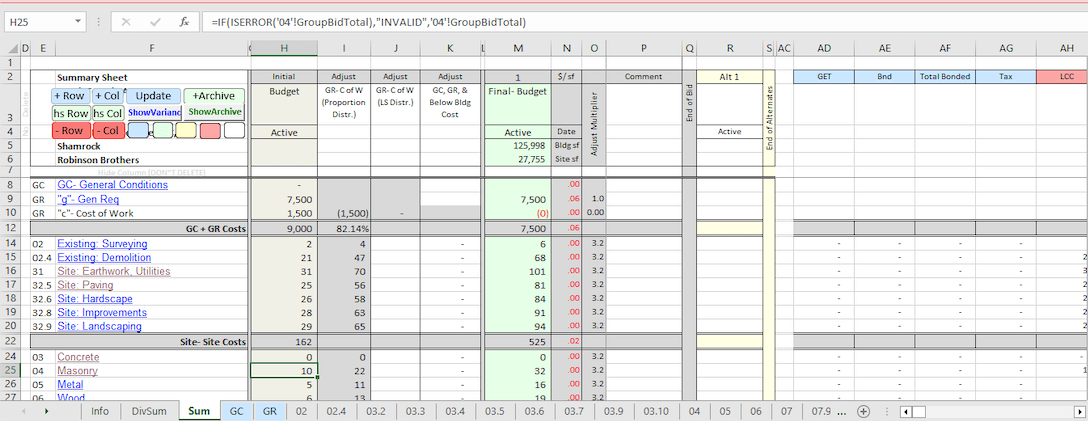
We’ve already set up tabs for all the relevant divisions including General requirements, Existing conditions, Concrete, Masonry, Metals, Soft costs, etc.
Your job is to input the items you got from your takeoff into the relevant bid tab. Each item has two rows of information that can be entered.
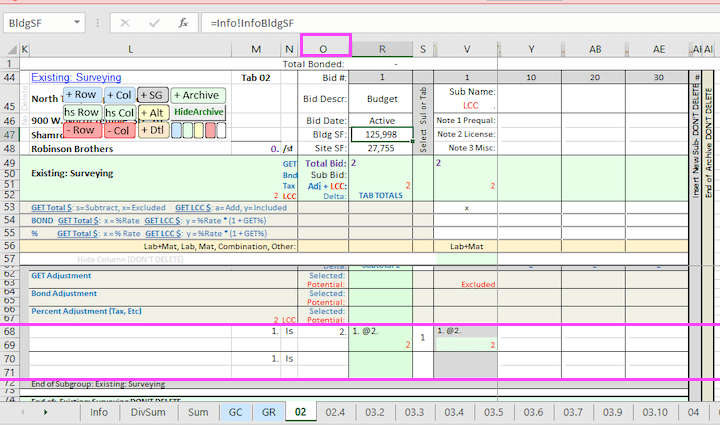
Typically, the first row is where you put the name of the item, quantity, unit, and unit price. On the second row, you can then add a second quantity, drawing reference, or any additional comment you think will be helpful.
Once that's done, enter the unit price for each item in column "O" and it will result in a budget in column “V”.
If the project requires that you break out a specific division into different levels, you can use subtotals for each subgroup. Here is an example of us breaking down concrete into 'Cast in place concrete' and 'reinforcing'.
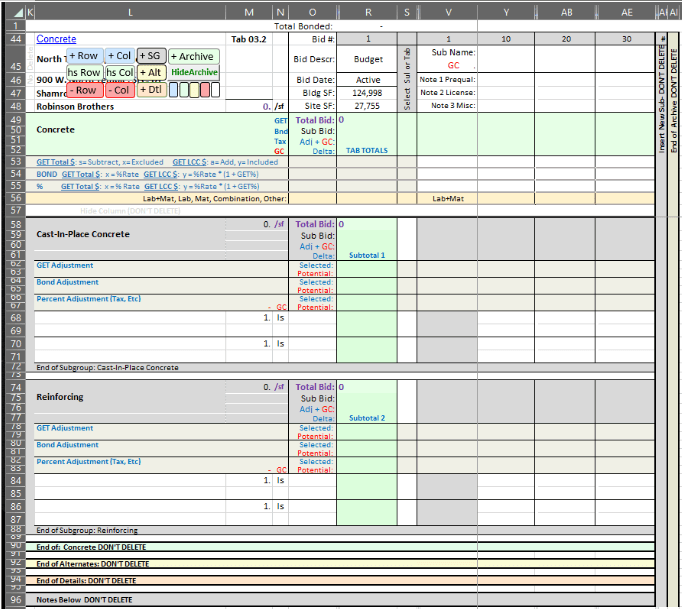
Our template also allows you to add alternates if it's part of the client's requirement. Totals for the “Alternate” are not included in the overall “TAB TOTALS” that appear at the top of the tab.
Here is an example of an alternate where the project owner did not want concrete stair pans.
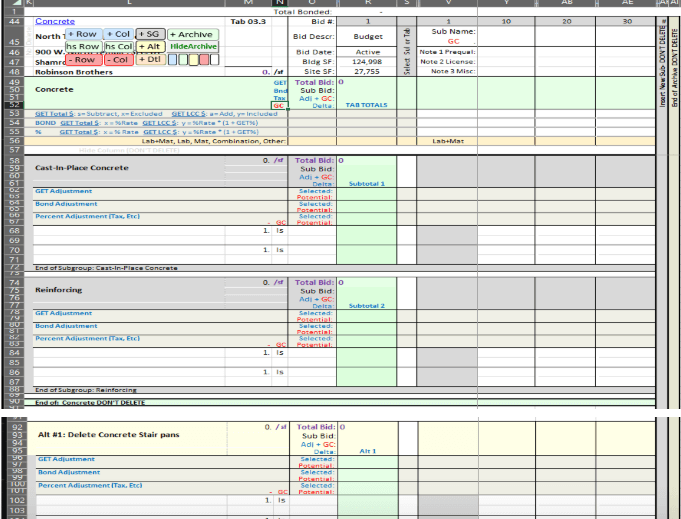
To level out bids, enter the subcontractor details in their specific column as well as the relevant information such as total bid cost and itemized cost.
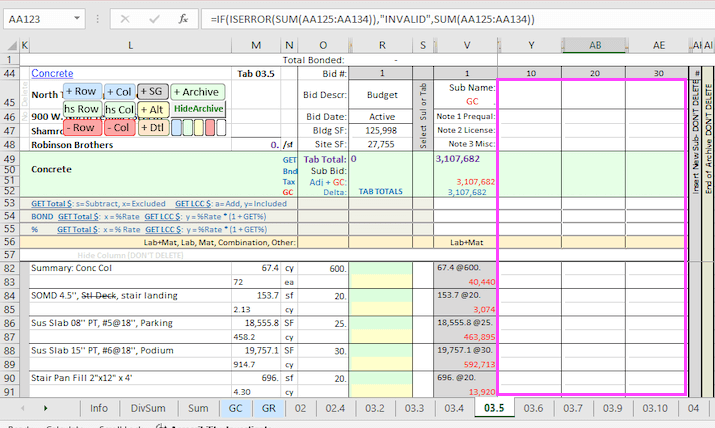
A line-by-line comparison of the received will help you determine whether a specific subcontractor missed important details in their proposal, and subsequently help you choose the best person for the job.
Another great thing about our free bid leveling template is that on top of the standard tabs that facilitate the leveling process, you also get additional tabs to further simplify the process.
These include:
Trade requirements tab
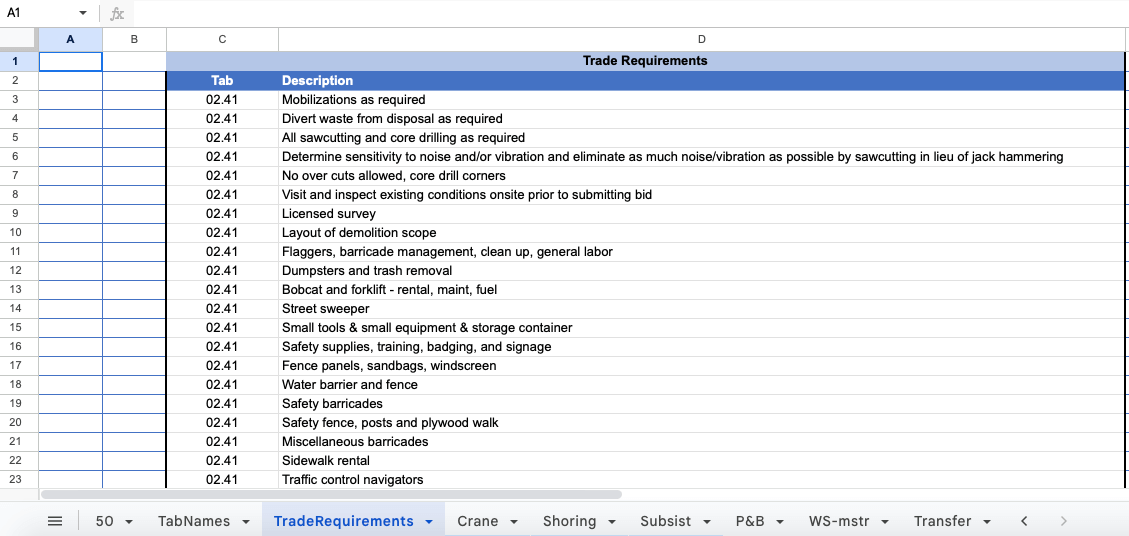
This tab contains a comprehensive list of the activities involved in each division and will play a key role in helping you qualify the subcontractors. Crosscheck their proposals against the list to ensure they have included all the steps in their scope of work.
Better yet, you can use the list in the pre-bid leveling stage when creating a scope of work to include in your Request for Proposal.
Crane & Material Hoist Tab
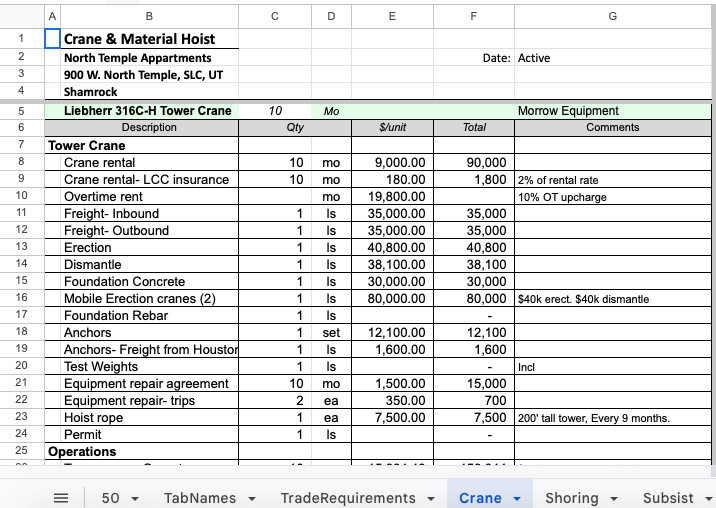
This tab will come in handy when estimating and managing costs associated with both crane and material hoist usage during the construction project. It includes costs for various activities such as crane rental, overtime rent, freight, erection, and dismantling.
You also get access to a bunch of other extra tabs to help you with the cost estimation for different activities including shoring and subsistence. The latter helps you estimate the cost of sustaining workers on the site. It has provisions for items such as apartments, internet, furniture, and transportation costs.
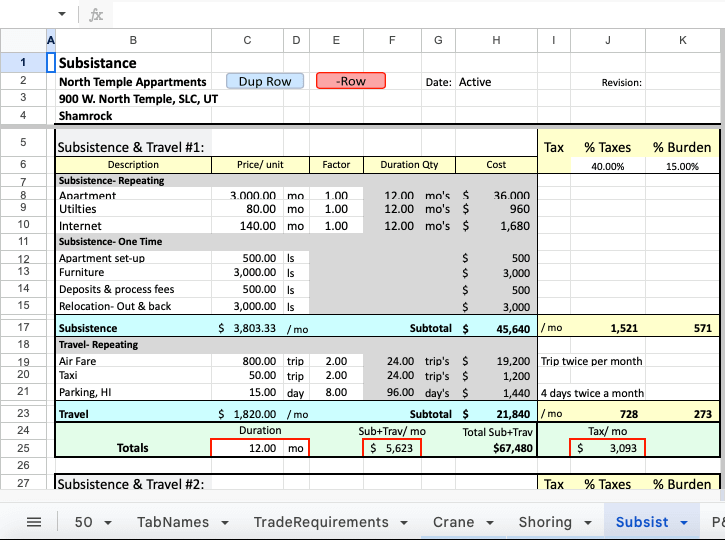
Download our free bid leveling template.
Tips and Best Practices To Simplify The Bid Leveling Process
Now that you have a comprehensive template to build on, here are two extra tips to ensure a smooth and efficient construction bidding leveling process.
1. Make Your RFP Exhaustive
Make sure that all the project requirements have been covered in your RFP. Go over the client's plan and drawings and come up with a list of deliverables that each subcontractor needs to meet. This will ensure that the bids you receive are consistent and you are comparing apples to apples.
So, instead of sending out an RFP for concrete work, break down the task into smaller specific tasks such as rebar caps & protection, shoring & reshoring, surface finish, embeds installment, etc.
Also, make sure to include your estimated bill of quantities, project timeline, construction labor costs, and other requirements for the job like terms of payment and bonding.
2. Enable Team Collaboration
If you have a team working on the construction bid leveling process, try to avoid a situation where each member downloads their version of the leveling sheet to work on it.
You can leverage Microsoft’s Sharepoint or even Google Sheets to enable real-time collaboration. This makes it very simple to keep track of all the changes in the doc and decreases the chance of someone messing with the formulas and formatting.
Take The Bidding Process To The Next Level With Downtobid
Our construction bid form template is just the tip of the iceberg. Downtobid is changing the bidding process through AI-powered automation.
To start with, you just upload construction plans to our platform, and our AI will automatically dissect it and facilitate the invitation process for the right subcontractors, eliminating manual analysis.
All the reasons you need to try Downtobid today
- An updated subcontractor database. We are offering an alternative subcontractor database free from all the common issues you've grown accustomed to. You don't have to worry about trades that are not mapped correctly to CSI codes or missing information such as contact data, union status, MBWE certification, or type of work done.
- Easy integration with takeoff tools. Downtobid connects directly with leading takeoff solutions to automatically import scope quantities into your estimates. We also provide a takeoff construction template you can make a copy of or download.
- Accurately estimated plug numbers. We have created a cost database based on historical bidding data and details from bidders' Excel in case you are still fresh in the business and don't have enough data to work with.
- A plan room where we collect behavioural data on how subs interact with your project. You also get additional features such as calendar syncing and real-time chat that facilitate easier communication with interested parties.
- A provision for leaving feedback on subcontractor bids to promote transparency.